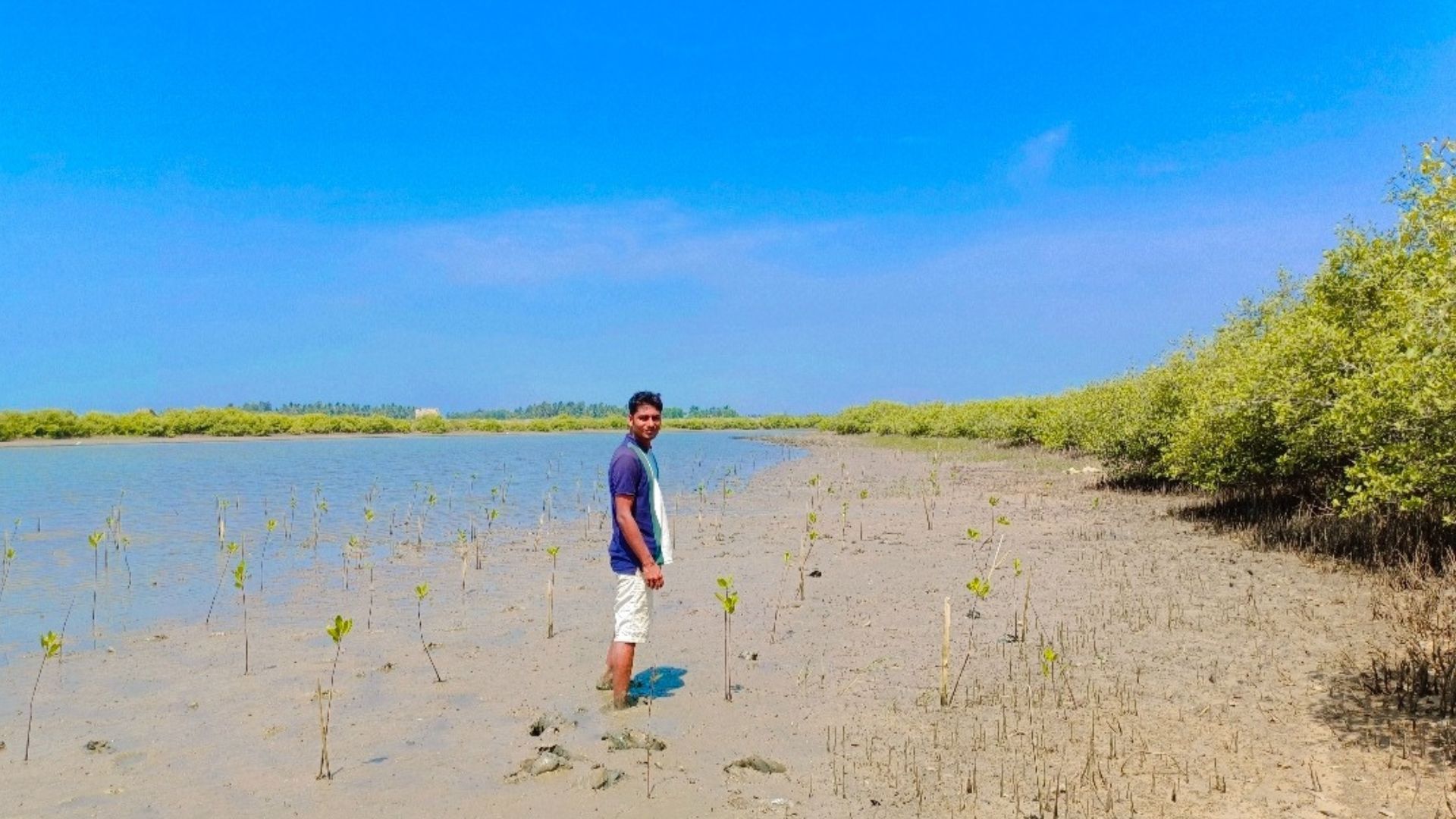Environmentalist Soumya Ranjan Biswal works on mangrove and wetland biodiversity conservation in Odisha.
July 2023

Soumya Ranjan Biswal has mobilized several campaigns to conserve the mangrove forest and olive ridley sea turtles’ habitat along the Odisha coast. (Photograph courtesy Soumya Ranjan Biswal)
Soumya Ranjan Biswal, a 26-year-old environmentalist, grew up watching olive ridley sea turtles nest on the shores of his home district Puri in Odisha. Over the years, he has also seen the nesting take a serious hit. For him, protecting these sea turtles and their habitat is more than just a cause. It’s a way of life.
Biswal is a member of the first cohort of the U.S. State Department funded-Climate Action Champions Network program and an alumnus of U.S. Consulate General Chennai’s TechCamp Kochi. In April 2023, he participated in an International Visitor Leadership Program (IVLP) on climate change and biodiversity conservation in the United States. The IVLP is the U.S. State Department’s premier professional exchange program. Biswal is also a managing trustee of the Odisha Paryavaran Sanrakshan Abhiyan Trust, a voluntary movement dedicated to preserving coastal biodiversity in rural Odisha. His activism is largely focused on raising awareness on climate change, environmental degradation and marine ecosystems along the Odisha coast.
A childhood spent on shores
Biswal is from Astaranga, a village in Odisha’s Devi river mouth area known for its rich marine biodiversity. Cherishing and conserving the mangroves and marine ecology around his village were an integral part of his childhood. Biswal says his first glimpse of the magnificent biodiversity of his village came from visits to the shore during 6th grade.
“Dr. Robert Sutcliffe, a dentist from Canada, would visit our school regularly and raise awareness about olive ridley turtle mortality on the Indian Coast,” remembers Biswal. “He would take us to the beach for clean-ups and provide study material, which instilled in me a love and care for the beach.”
Olive ridleys are known for their mass nestings in Odisha making it the largest mass nesting site in the world. The areas of Rushikulya, Gahirmatha and the Devi river mouth are three key nesting zones. Biswal says he has patrolled the Devi river mouth beaches since childhood, protecting the turtle nests from predators like snakes, dogs, pigs and crabs.
“I realized that coastal biodiversity conservation is an important tool for preserving the ecosystem and securing it from cyclonic storms and climate crises,” he says. “In 2014, I mobilized my college friends and started working toward conserving the mangrove forests and olive ridley turtles.”
Saving the mangroves
Known to act as a buffer against natural disasters, mangroves are subtropical trees that flourish in standing, salty water and are found along the coast in West Bengal, Odisha, Andhra Pradesh, Maharashtra, Gujarat and the Andaman and Nicobar Islands. “The dense network of roots and branches of mangroves traps sediments and reduces the impact of waves and tides, which can help protect coastal communities from flooding and erosion,” explains Biswal.
Biswal’s drive to save the mangroves is also a tale of survival. “In recent years, the Devi river mouth area has experienced several natural calamities, including cyclones and floods, which have caused significant damage to the local communities and their livelihoods,” he explains. “The mangrove forests have played a critical role in protecting the lives and property of the people in the area.”
Biswal says the presence of mangroves on the Astaranga coast diverted the path of Cyclone Fani’s landfall in 2019, saving the village from destruction. “Cyclone Fani was expected to make landfall in the Astaranga area, but later it changed direction. We believe it was because of the mangroves,” he says.
Biswal’s activism to save the mangrove forests took root early in life. “There were just two lines that mentioned how mangroves protect shorelines in my 10th grade geography book,” he says. “I realized that there was zero awareness among the public about the importance of mangroves and wetlands in combating climate change and protecting the environment. People were cutting down mangroves and encroaching on wetlands without realizing the consequences of their actions.”
In 2014, Biswal mobilized awareness campaigns on the importance of mangroves and wetlands. “I used my limited resources to organize cycle rallies, street rallies, mural painting and school awareness programs,” he explains.
A year later, he started regularly patrolling the river banks adjoining the mangroves by bicycle, covering about 30 villages and wards between the Devi river mouth and the Kadua river mouth in the Puri district.
His patrolling drew the local administration’s attention and wetland encroachment has reduced significantly. Biswal says so far, about 8,000 students in the region have pledged to control the river and mangrove pollution, protect mangroves with their families, and promote wetland awareness.
Going forward, Biswal says his goal is to raise awareness about climate change on the Odisha coast by creating a network of communities, youth and policymakers who are most affected by it. And most of all, he wants to continue his work protecting the mangrove forests and nesting grounds of olive ridley turtles, but now with greater support and resources.
Click here to sign up for the free SPAN newsletter: https://bit.ly/SubscribeSPAN
Dear Biswal, you are doing a great help to our nature. To love nature means to love mankind .your work be an example to the world. I wish you good luck.
Babu M
Dear Biswal, you are doing a great help to our nature. To love nature means to love mankind .your work be an example to the world. I wish you good luck.